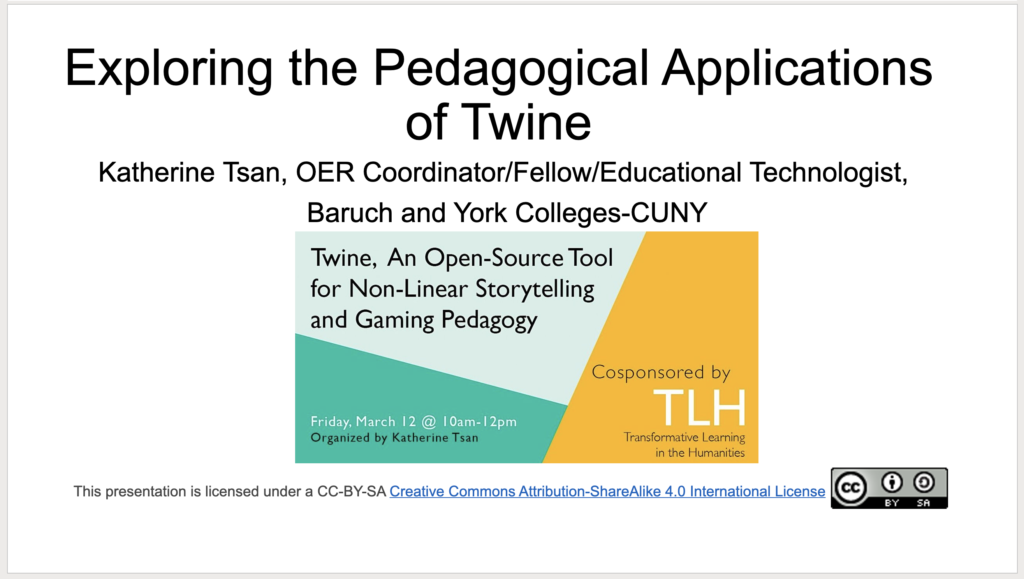This blog post was written by Contributing Author Katherine Tsan (Baruch College and York College), Open Educational Resources coordinator and educational technologist.
I organized the seminar that ran on March 12, 2021, from 10 to noon, with the title Twine, An Open-Source Tool for Non-Linear Storytelling and Gaming Pedagogy. This hypertext decision-tree game-making platform has meant much for me as an educator, given its versatility, its simplicity, and its history of accommodating individual stories that highlight personal agency (a key reason it has become the vehicle for creating “games” that portray the struggle of people living with depression, and the experience of marginalized communities).
I had earlier interviewed Chris Klimas, Twine’s creator, getting his take on what Twine’s development over the past decade has been like, what the future holds and how it can be scaled for higher education. Chris agreed to co-lead this TLH workshop, introducing Twine, taking the audience through a short playtest and supervising the creation of their own games. I, meanwhile, put together a presentation about the educational uses of Twine with assignment prompts in different disciplines.

I was overall happy with the way the workshop turned out. Chris’ introduction was informative and effectively communicated how this simple programming tool can carry through profound ideas (view the slide deck here). In particular, he showcased ways in which Twine can be usable as an educational and practical vehicle for learning, especially experiential learning and simulations. One example was https://caitkirby.com/downloads/Fall%202020.html — a mini-simulation of schools’ reopening in 2020 that also expresses an opinion. Another usage of Twine that made an impression on the audience was https://www.virtualanaesthetics.com, a “game” that puts someone in the shoes of the person in the actual situation, i.e. assessing the management of chronic pain. Building this virtual scenario, Chris related, is easier and faster than hiring actors or creating a real-life simulation. For my part of the presentation, I was glad I could convince at least some practitioners of science that Twine is not just a writing tool but might work for their subject as well. I hope some of those lessons will translate into workable games and assignments.
The one disappointing aspect of the workshop for me was after Chris went through the basics of creating a very simple story with Twine, emphasizing how the tool “offers a way to build something and validate whether it’s working.” He then showed ways to add complexity and levels of action to the narrative, introducing such terms as paths, modifiers and variables. Despite his words that “Complexity is useful but not absolutely necessary,” I saw the workshop attendance immediately go down by half. The dozen attendees who were left enthusiastically worked through their own Twine projects. That is perhaps as much as one can hope for in these pandemic times.
I am still pursuing my dream of introducing Twine to large swaths of the CUNY community, and see this as a promising beginning. I am grateful to TLH for giving me this opportunity to introduce Chris Klimas and Twine to a number of faculty members.
Katherine Tsan (Baruch College and York College) is an Open Educational Resources coordinator and educational technologist.



Perhaps after reading this article, you can gain more knowledge by reading the following articles.
https://healthy-nature.tw/